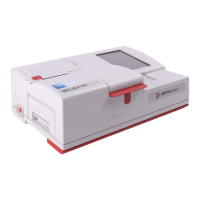Operator’s Manual – OPTI CCA-TS2 K-1
ANALYTES POTASSIUM
Potassium (K
+
)
Clinical Signicance
1
Potassium is the major cation in the intracellular uid and functions as the primary buffer within the cell
itself. Ninety percent of potassium is concentrated within the cell, and damaged cells release potassium
into the blood. Potassium plays an important role in nerve conduction, muscle function, and helps
maintain acid-base balance and osmotic pressure.
Elevated potassium levels, hyperkalemia, can be found in oligouria, anemia, urinary obstruction, renal
failure due to nephritis or shock, metabolic or respiratory acidosis, renal tubular acidosis with the K
+
/
H
+
exchange and hemolysis of the blood. Low potassium levels, hypokalemia, can be found in excessive
loss of potassium through diarrhea or vomiting, inadequate intake of potassium, malabsorption, severe
burns and increased secretion of aldosterone. High or low potassium levels may cause changes in muscle
irritability, respiration and myocardial function.
The potassium value obtained may be used to monitor electrolyte imbalance in the diagnosis and
treatment of infusion therapies, shock, heart or circulatory insufciency, acid-base imbalance, therapy
with diuretics, all kinds of kidney problems, diarrhea, hyper- and hypo-function of adrenal cortex and
other diseases involving electrolyte imbalance.
Measurement Principle
The K
+
ion optodes are closely related to the more familiar Ion Selective Electrodes (ISEs).
The optodes use ion selective recognition elements (ionophores) similar to those used in ISEs, however
the ionophores are linked to uorescent dyes instead of electrodes. These types of dyes have been
used since the 1970’s to visualize and quantify cellular ion levels in uorescence microscopy and cell
counters
2
. As the ion concentration increases, these ionophores bind larger amounts of ions and cause the
uorescence intensity to increase or decrease, depending on the particular ion. Like the pH optode, the
ion optodes do not need a reference electrode, however, several of them do exhibit a small pH sensitivity
which is automatically compensated in the OPTI CCA-TS2 using the measured pH.
Measurement Range
Range Resolution (Low/High) Units
0.8 to 9.99 0.1/0.01 mmol/L
Standard Reference Cassette (SRC) Limit Values
LOW NORMAL HIGH Units
2.5 ± 0.3 4.5 ± 0.3 7.0 ± 0.3 mmol/L

